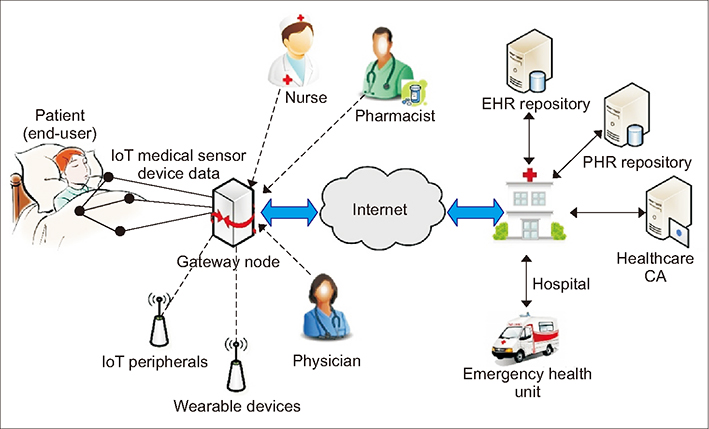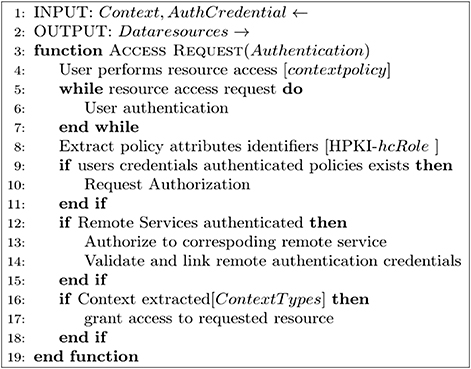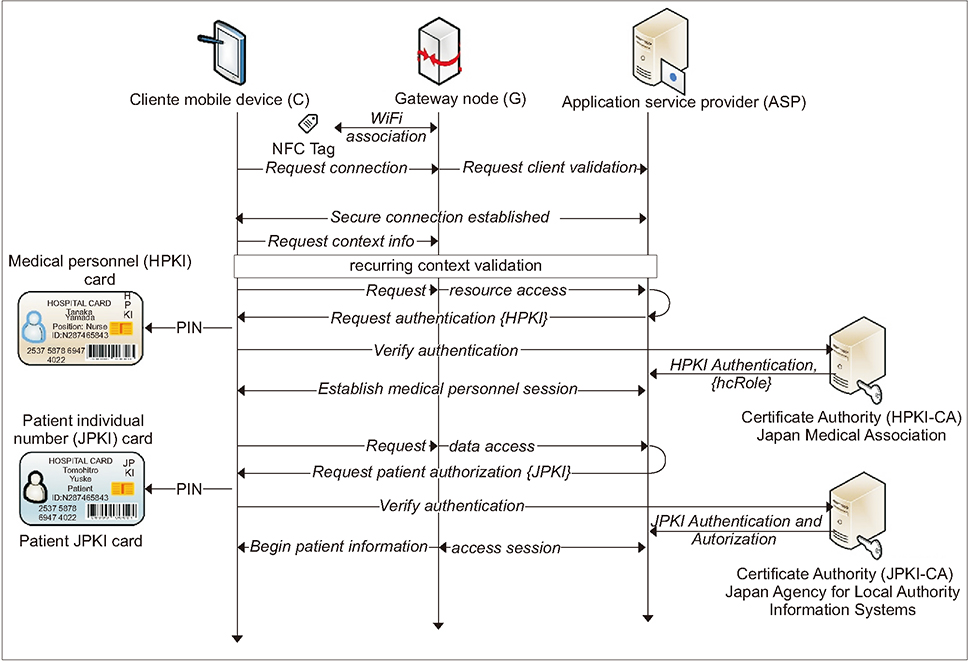Healthc Inform Res.
2019 Apr;25(2):106-114. 10.4258/hir.2019.25.2.106.
Privacy Enhanced Healthcare Information Sharing System for Home-Based Care Environments
- Affiliations
-
- 1Tokyo Institute of Technology, Yokohama, Japan. j-lee@isl.titech.ac.jp
- 2Tokyo Medical and Dental University, Tokyo, Japan.
- KMID: 2445007
- DOI: http://doi.org/10.4258/hir.2019.25.2.106
Abstract
OBJECTIVES
Home-based nursing care services have increased over the past decade. However, accountability and privacy issues as well as security concerns become more challenging during care provider visits. Because of the heterogeneous combination of mobile and stationary assistive medical care devices, conventional systems lack architectural consistency, which leads to inherent time delays and inaccuracies in sharing information. The goal of our study is to develop an architecture that meets the competing goals of accountability and privacy and enhances security in distributed home-based care systems.
METHODS
We realized this by using a context-aware approach to manage access to remote data. Our architecture uses a public certification service for individuals, the Japanese Public Key Infrastructure and Health Informatics-PKI to identify and validate the attributes of medical personnel. Both PKI mechanisms are provided by using separate smart cards issued by the government.
RESULTS
Context-awareness enables users to have appropriate data access in home-based nursing environments. Our architecture ensures that healthcare providers perform the needed home care services by accessing patient data online and recording transactions.
CONCLUSIONS
The proposed method aims to enhance healthcare data access and secure information delivery to preserve user's privacy. We implemented a prototype system and confirmed its feasibility by experimental evaluation. Our research can contribute to reducing patient neglect and wrongful treatment, and thus reduce health insurance costs by ensuring correct insurance claims. Our study can provide a baseline towards building distinctive intelligent treatment options to clinicians and serve as a model for home-based nursing care.
Keyword
MeSH Terms
-
Asian Continental Ancestry Group
Certification
Computer Security
Delivery of Health Care*
Electronic Health Records
Health Information Exchange
Health Personnel
Health Smart Cards
Home Care Services
Home Health Nursing
Humans
Information Dissemination*
Insurance
Insurance, Health
Methods
Nursing
Nursing Care
Privacy*
Social Responsibility
Figure
Reference
-
1. Japanese Nursing Association. Nursing for the older people in Japan. 2. Nursing for the Older People: Current situation and challenges [Internet]. Tokyo, Japan: Japanese Nursing Association;2013. cited at 2019 Apr 1. Available from: https://www.nurse.or.jp/jna/english/pdf/info-02.pdf.2. Obi T, Ishmatova D, Iwasaki N. Promoting ICT innovations for the ageing population in Japan. Int J Med Inform. 2013; 82:e47–e62.
Article3. Maruyama I. The new direction of primary care in Japan. Japan Med Assoc J. 2013; 56(6):465–467.4. Fujimoto M, Miyazaki K, von Tunzelmann N. Complex systems in technology and policy: telemedicine and telecare in Japan. J Telemed Telecare. 2000; 6(4):187–192.
Article5. Ministry of Health, Labour and Welfare. Guidelines for the security management of health information systems edition 4.2. Tokyo, Japan: Ministry of Health, Labour and Welfare;2013.6. Park A, Chang H, Lee KJ. Action research on development and application of Internet of Things services in hospital. Healthc Inform Res. 2017; 23(1):25–34.
Article7. Lee JD, Yoon TS, Chung SH, Cha HS. Service-oriented security framework for remote medical services in the Internet of Things environment. Healthc Inform Res. 2015; 21(4):271–282.
Article8. Kumar P, Lee HJ. Security issues in healthcare applications using wireless medical sensor networks: a survey. Sensors (Basel). 2012; 12(1):55–91.
Article9. Fukuda K, Obi T, Nagata K, Suzuki H, Taira N, Ohyama N. A study on utilizing the public certification service for individuals in the qualification of medical insurance. 2016 Life Intelligence and Office Information Systems (LIOS). Tokyo, Japan: p. 1–5.10. Obi T, Fujita K, Ohyama N. A study on functionality expansion and medical application of new public Certification Service for Individuals. In : Proceedings of the 31st Symposium on Cryptography and Information Security (SCIS); 2014 Jan 21–24; Kagoshima, Japan. p. 29–34.11. Ministry of Internal Affairs and Communication. About public personal certification system. Tokyo, Japan: Ministry of Internal Affairs and Communication;2018.12. Sufi F, Khalil I, Tari Z. A cardiod based technique to identify cardiovascular diseases using mobile phones and body sensors. In : Proceedings of 2010 Annual International Conference of the IEEE Engineering in Medicine and Biology; 2010 Aug 31–Sep 4; Buenos Aires, Argentina. p. 5500–5503.13. Dey AK. Understanding and using context. Pers Ubiquitous Comput. 2001; 5(1):4–7.
Article14. Hristova A, Bernardos AM, Casar JR. Context-aware services for ambient assisted living: a case-study. In : Proceedings of 2008 First International Symposium on Applied Sciences on Biomedical and Communication Technologies; 2008 Oct 25–28; Aalborg, Denmark. p. 1–5.15. Viswanathan H, Chen B, Pompili D. Research challenges in computation, communication, and context awareness for ubiquitous healthcare. IEEE Commun Mag. 2012; 50(5):92–99.
Article16. Paganelli F, Spinicci E, Giuli D. ERMHAN: a contextaware service platform to support continuous care networks for home-based Assistance. Int J Telemed Appl. 2008; 2008:867639.
Article17. Sun J, Reddy CK. Big data analytics for healthcare. In : Proceedings of the 19th ACM SIGKDD International Conference on Knowledge Discovery and Data Mining; 2013 Aug 11–14; Chicago, IL. 2013. 08. p. 1525.18. International Standardization Organization. ISO 17090-3:2008 Health informatics - Public key infrastructure [Internet]. Geneva, Switzerland: International Standardization Organization;2008. cited at 2019 Apr 1. Available from: https://www.iso.org/obp/ui/#iso:std:iso:17090:-3:ed-1:v1:en.19. Tanaka K, Yoshida M, Yamamoto R. Secure remote access for web based clinical information system using policy control of pcs and healthcare PKI authentication. In : Proceedings of the 12th World Congress on Health (Medical) Informatics, Building Sustainable Health Systems; 2007 Aug 20–24; Brisbane, Australia. p. 1644–1646.20. Tripathi MM, Joshi NK. Big data issues in medical healthcare. Intelligent Communication, Control and Devices. Singapore: Springer;2018. p. 1757–1765.21. Choi HK, Shin KE, Kim H. A healthcare information system for secure delivery and remote management of medical records. IEICE Trans Inf Syst. 2016; 99(4):883–890.
Article22. Bauer AM, Rue T, Munson SA, Ghomi RH, Keppel GA, Cole AM, et al. Patient-oriented health technologies: patients' perspectives and use. J Mob Technol Med. 2017; 6(2):1–10.
Article
- Full Text Links
- Actions
-
Cited
- CITED
-
- Close
- Share
- Similar articles
-
- Survey on the Consumers' Attitudes towards Health Information Privacy
- Development of a Database System for Home Care Service Based on RAI(Resident Assessment Instrument)
- Strategies for Protecting the Privacy in Genetic Testing
- The Effects of ICT Enhanced Home-visit Nursing in Long-Term Care Insurance on Health-related Quality of Life among Community-Dwelling Older Adults
- Ethics for Artificial Intelligence: Focus on the Use of Radiology Images








